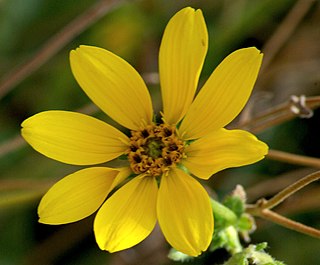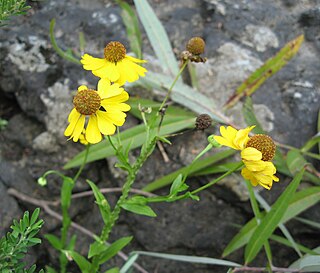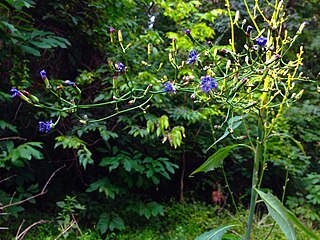
Leucanthemum vulgare, commonly known as the ox-eye daisy, oxeye daisy, dog daisy, marguerite and other common names, is a widespread flowering plant native to Europe and the temperate regions of Asia, and an introduced plant to North America, Australia and New Zealand.

Rudbeckia hirta, commonly called black-eyed Susan, is a North American flowering plant in the family Asteraceae, native to Eastern and Central North America and naturalized in the Western part of the continent as well as in China. It has now been found in all 10 Canadian Provinces and all 48 of the states in the contiguous United States.

Gaillardia pulchella is a North American species of short-lived perennial or annual flowering plants in the sunflower family.

Erigeron compositus is an Arctic and alpine species of fleabane in the family Asteraceae. Common names include dwarf mountain fleabane, cutleaf daisy, and trifid mountain fleabane.

Eupatorium altissimum, with the common names tall thoroughwort and tall boneset, is a perennial herbaceous plant in the Asteraceae family with a native range including much of the eastern and central United States and Canada. It is a tall plant found in open woods, prairies, fields, and waste areas, with white flowers that bloom in the late summer and fall.

Erechtites hieraciifolius is a plant in the daisy family, Asteraceae. It is native to the Americas, but is found many places around the world having been introduced by human activity. It is introduced in Hawaii, China, and Southeast Asia.

Helenium bolanderi is a North American species of flowering plant in the daisy family known by the common name coastal sneezeweed. It is native to southern Oregon and northern California as far south as Mendocino County, primarily along the seacoast.

Helianthus maximiliani is a North American species of sunflower known by the common name Maximilian sunflower.

Cirsium discolor, the field thistle, is a North American species of plants in the tribe Cardueae within the family Asteraceae. It is native to thirty-three states in the United States as well four Canadian provinces. It occurs across much of eastern and central Canada as well as eastern and central United States. It has been found from New Brunswick west to Saskatchewan and south as far as Texas and Georgia.

Helianthus grosseserratus, commonly known as sawtooth sunflower or thick-tooth sunflower, is a perennial sunflower in the family Asteraceae, with a large flowering head (inflorescence).

Engelmannia, or Engelmann's daisy, is a genus of North American flowering plants in the family Asteraceae.
Engelmannia pinnatifida is a North American species of flowering plants in the family Asteraceae. It is native to the southern United States and northern Mexico, the States of Chihuahua, Coahuila, Nuevo León, Tamaulipas, Texas, New Mexico

Helenium flexuosum is a North American plant species in the daisy family known by the common name purple sneezeweed. It is widespread across much of eastern and central United States and Canada, from Nova Scotia west to Ontario, Minnesota, and Kansas, south to Florida, Louisiana, and eastern Texas.

Tetraneuris acaulis is a North American species of flowering plants in the sunflower family. Common names include angelita daisy, stemless four-nerve daisy, stemless hymenoxys, butte marigold, and stemless rubberweed.
Cirsium carolinianum is a North American species of plants in the tribe Cardueae within the family Asteraceae. Common name is Carolina thistle or purple thistle or soft thistle or smallhead thistle. The species is native to the central and southern United States, from eastern Texas east to Virginia and the Carolinas, north to the Ohio Valley.

Elephantopus carolinianus, with the common names Carolina elephantsfoot or leafy elephant's foot, is a species of flowering plant in the Asteraceae family. It is native to the south-central and southeastern United States.

Hieracium longipilum, the hairy hawkweed, is a North American plant species in the tribe Cichorieae within the family Asteraceae. It is widespread across much of central Canada and the central United States from Ontario south to Texas and Louisiana. There are old reports of the species growing in Québec, but apparently does not grow there now.

Hieracium scabrum, the rough hawkweed, is a North American plant species in the tribe Cichorieae within the family Asteraceae. It is native to eastern and central Canada and the eastern and central United States from Nova Scotia west to Ontario, Minnesota, and Kansas south as far as Georgia and Oklahoma.

Lactuca floridana, commonly known as woodland lettuce, Florida lettuce, or false lettuce is a North American species of wild lettuce. It is native across much of central Canada and the eastern and central United States.

Calyptocarpus vialis is a species of flowering plant in the family Asteraceae. Common names for C. vialis include straggler daisy, horseherb, lawnflower, and creeping Cinderella-weed. It is native to south Texas, Mexico, Belize, Venezuela, and the Caribbean. It has also been introduced east of Texas, Argentina, Hawaii, India, Java, Australia, and Taiwan. It is one of only three species in the genus Calyptocarpus.



















